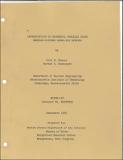| dc.contributor.author | Hamawi, John Nicholas | en_US |
| dc.contributor.author | Rasmussen, Norman C. | en_US |
| dc.contributor.other | Massachusetts Institute of Technology. Department of Nuclear Engineering | en_US |
| dc.contributor.other | Morgantown Coal Research Center (U.S.) | en_US |
| dc.date.accessioned | 2014-09-16T23:31:32Z | |
| dc.date.available | 2014-09-16T23:31:32Z | |
| dc.date.issued | 1969 | en_US |
| dc.identifier.uri | http://hdl.handle.net/1721.1/89701 | |
| dc.description | "September 1969." | en_US |
| dc.description | "Prepared for United States Department of the Interior Bureau of Mines Morgantown Research Center Morgantown, West Virginia." | en_US |
| dc.description | Also issued as a Ph. D. thesis, written by the first author and supervised by the second author, MIT, Dept. of Nuclear Engineering, 1969 | en_US |
| dc.description | Includes bibliographical references (pages 307-312) | en_US |
| dc.description.abstract | This thesis evaluated the potential of neutron-capture gamma rays in elemental analysis. A large portion of the work was devoted to the development of a method for the analysis of weak peaks in gamma ray spectra. This was based on equations developed for the standard deviation in the measurement of the various peak parameters, consideration being also given to the reduction in the statistical fluctuations obtained by smoothing the data with the use of Fourier transforms. Two methods of peak area determination were considered end their relative effectiveness examined. An equation was then derived for the minimum weight of an element needed for reliable quantitative analysis. The equations were verified using both real and pseudo-experimental data constructed with the use of a computer. Experiments were carried out using the MIT Reactor with samples positioned La) in a high neutron flux next to the reactor tank (2xl01- n/sq.cm sec), and (b) in an external neutron beam facility of relatively lower but well thermalized flux (2xl0 n/sq.cm sec). Capture gamma ray spectra were obtained with a three-crystal system capable of operating in the free mode, the Compton suppression mode and as a pair spectrometer. The results were used to examine the relative analytical sensitivity of the internal and external sample arrangements and the various gamma detection modes. The minimum measurable weights of 75 elements were evaluated for a stainless steel sample. For these computations use was made of the listing of capture gamma ray spectra recently established by the MIT gamma spectroscopy group. 'In a majority of the cases the detection limits range between 0.1 percent and 10 percent. Equations were developed for extending the results to different samples and different. experimental arrangements. | en_US |
| dc.description.sponsorship | Contract no. H0180895 | en_US |
| dc.format.extent | 312 pages | en_US |
| dc.publisher | Cambridge, Mass. : Dept. of Nuclear Engineering, Massachusetts Institute of Technology, [1969] | en_US |
| dc.relation.ispartofseries | MITNE ; no. 107 | en_US |
| dc.subject.lcc | TK9008.M41 N96 no.107 | en_US |
| dc.subject.lcsh | Neutrons -- Capture | en_US |
| dc.subject.lcsh | Gamma ray spectrometry | en_US |
| dc.title | Investigation of elemental analysis using neutron-capture gamma ray spectra | en_US |
| dc.type | Technical Report | en_US |
| dc.identifier.oclc | 856584872 | en_US |
